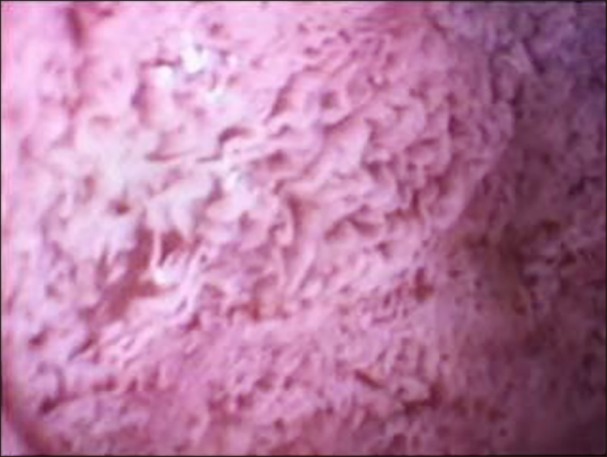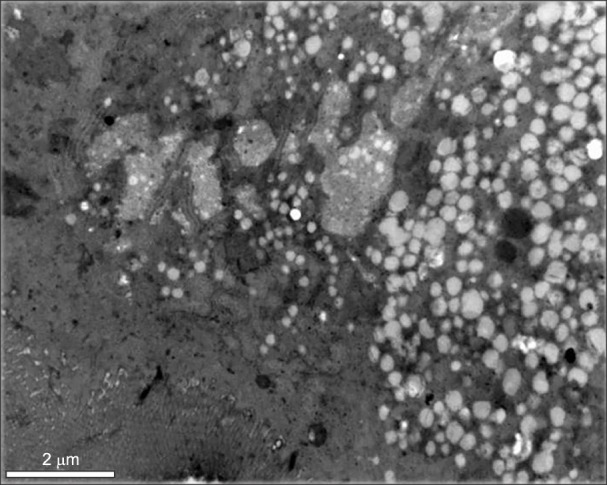Pediatr Gastroenterol Hepatol Nutr.
2018 Apr;21(2):134-140. 10.5223/pghn.2018.21.2.134.
Chylomicron Retention Disease: a Description of a New Mutation in a Very Rare Disease
- Affiliations
-
- 1Department of Pediatric, Hospital da Senhora da Oliveira, Guimarães, Portugal. helena-of@hotmail.com
- 2Department of Pediatric and Gastroenterology, Hepatology, Nutritional Support and Liver Transplant Unit, Hospital Universitário Vall d'Hebron, Barcelona, Spain.
- KMID: 2409365
- DOI: http://doi.org/10.5223/pghn.2018.21.2.134
Abstract
- Chylomicron retention disease, also known as Anderson's disease, is a rare hereditary hypocholesterolemic disorder, recessive inherited, characterized by nonspecific symptoms as abdominal distension, steatorrhea, and vomiting associated with failure to thrive. We describe a patient with failure to thrive, chronic diarrhea and steatorrhea who the diagnosis of chylomicron retention disease was established after several months of disease progression. The genetic study confirmed a homozygosity mutation in SAR1B gene, identifying a mutation never previous described [c.83_84delTG(p.Leu28Argfs*7)]. With this case report the authors aim to highlight for this very rare cause of failure to thrive and for the importance of an attempting diagnosis, in order to start adequate management with low fat diet supplemented with fat-soluble vitamins, reverting the state of malnutrition and avoiding possible irreversible and desvantating complications.
Keyword
MeSH Terms
Figure
Reference
-
1. Jaffe AC. Failure to thrive: current clinical concepts. Pediatr Rev. 2011; 32:100–107. PMID: 21364013.
Article2. Peretti N, Sassolas A, Roy CC, Deslandres C, Charcosset M, Castagnetti J, et al. Guidelines for the diagnosis and management of chylomicron retention disease based on a review of the literature and the experience of two centers. Orphanet J Rare Dis. 2010; 5:24. PMID: 20920215.
Article3. Okada T, Miyashita M, Fukuhara J, Sugitani M, Ueno T, Samson-Bouma ME, et al. Anderson's disease/chylomicron retention disease in a Japanese patient with uniparental disomy 7 and a normal SAR1B gene protein coding sequence. Orphanet J Rare Dis. 2011; 6:78. PMID: 22104167.
Article4. Peretti N, Roy CC, Sassolas A, Deslandres C, Drouin E, Rasquin A, et al. Chylomicron retention disease: a long term study of two cohorts. Mol Genet Metab. 2009; 97:136–142. PMID: 19285442.
Article5. Sassolas A, Filippo MD, Aggerbeck LP, Peretti N, Samson-Bouma ME. Cooper David, editor. Anderson's Disease/Chylomicron Retention Disease and Mutations in the SAR1B Gene, Mutations in Human Genetic Disease. InTech;2012. DOI: 10.5772/45975. Available from: https://www.intechopen.com/books/mutations-in-human-genetic-disease/anderson-s-disease-chylomicron-retention-disease-and-mutationsin-the-sar1b-gene.6. Papadogeorgou P, Roma E, Sassolas A, Orfanou I, Malliarou A, Sakka S, et al. Chylomicron retention disease: report of two cases from a Greek Island. J Pediatr Endocrinol Metab. 2012; 25:1191–1194. PMID: 23329770.
Article7. Ben Ameur S, Aloulou H, Jlidi N, Kamoun F, Chabchoub I, Di Filippo M, et al. Chylomicron retention disease: a rare cause of chronic diarrhea. Arch Pediatr. 2016; 23:735–737. PMID: 27266643.
Article8. Magnolo L, Najah M, Fancello T, Di Leo E, Pinotti E, Brini I, et al. Novel mutations in SAR1B and MTTP genes in Tunisian children with chylomicron retention disease and abetalipoproteinemia. Gene. 2013; 512:28–34. PMID: 23043934.
Article9. Desaldeleer C, Henno S, Bruneau B, Dabadie A. Chylomicron retention disease. Dig Liver Dis. 2013; 45:e3. PMID: 22959141.
Article
- Full Text Links
- Actions
-
Cited
- CITED
-
- Close
- Share
- Similar articles
-
- A Case of Imperforated Hymen Associated with Acute Urinary Retention
- The Role of Capsule Endoscopy in the Diagnosis of Crohn's Disease
- The G2019S LRRK2 Mutation is Rare in Korean Patients with Parkinson's Disease and Multiple System Atrophy
- Clinical Features of Genetic Creutzfeldt-Jakob Disease with E200K Mutation
- A Case of Acute Urinary Retention Caused by Hematocolpos Secondary to Imperforate Hymen



